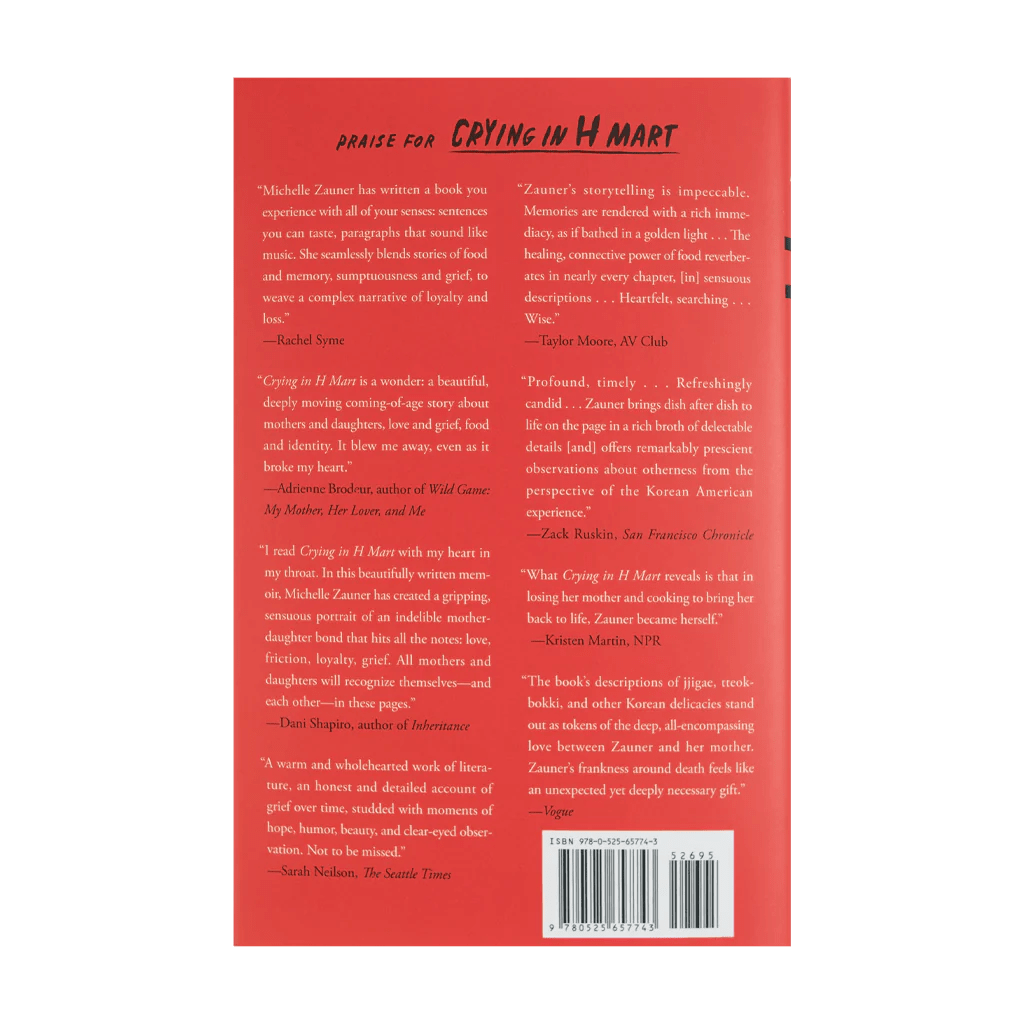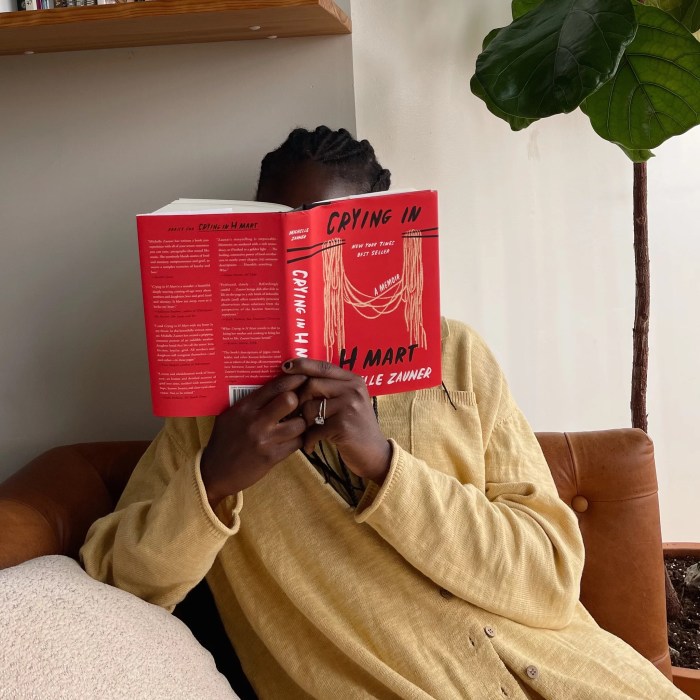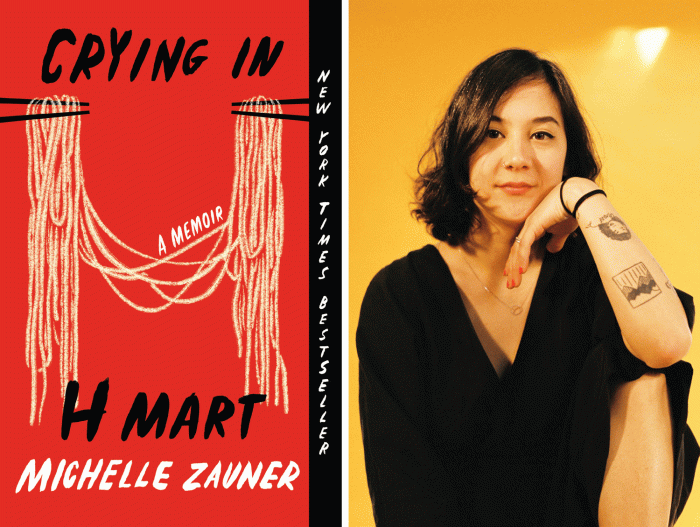As “Crying in H Mart Questions” takes center stage, this opening passage beckons readers into a world crafted with meticulous care, ensuring a reading experience that is both absorbing and distinctly original.
Michelle Zauner’s memoir, “Crying in H Mart,” is a poignant exploration of grief, cultural identity, and the healing power of storytelling. Through her experiences in the aisles of H Mart, a Korean grocery store, Zauner delves into the complexities of loss, memory, and the search for belonging.
Introduction to Crying in H Mart
Michelle Zauner’s memoir, “Crying in H Mart,” is a poignant and deeply personal account of her experiences navigating grief and loss following the death of her mother.
The H Mart, a Korean grocery store chain, serves as a central setting in the book, representing a space where Zauner seeks solace and connection with her Korean heritage.
Cultural and Emotional Themes
The memoir explores themes of cultural identity, family, and the complexities of mourning. Zauner’s Korean-American background and her mother’s Korean culture heavily influence her experiences and the ways in which she processes her grief.
Through her narrative, Zauner sheds light on the cultural differences and challenges faced by immigrants and second-generation Asian Americans, while also delving into the universal emotions of loss and longing.
Grief and Loss

Zauner’s grief over her mother’s death is profoundly expressed through her experiences in H Mart. The Korean grocery store becomes a sanctuary where she can connect with her mother’s memory and navigate the complexities of her loss.
Food and Cooking as Symbols
Food and cooking play a central role in Zauner’s grieving process. The flavors and aromas of Korean cuisine evoke memories of her mother and provide a sense of comfort. By preparing her mother’s recipes, Zauner attempts to preserve her legacy and feel closer to her.
However, cooking also becomes a reminder of her loss, highlighting the absence of her mother’s presence.
Rituals and Traditions
Rituals and traditions are integral to Zauner’s coping with grief. She finds solace in observing Korean customs, such as preparing food for her mother’s ancestors and participating in the traditional Korean funeral rite known as “sutja.” These rituals provide a sense of structure and continuity, helping Zauner to process her emotions and connect with her Korean heritage.
Cultural Identity and Assimilation: Crying In H Mart Questions

In Crying in H Mart, Michelle Zauner’s Korean heritage and American upbringing create a complex interplay of cultural identity. H Mart, a Korean grocery store, becomes a sanctuary where she can reconnect with her roots while navigating the challenges of assimilation.
H Mart as a Cultural Nexus
H Mart provides a tangible link to Zauner’s Korean culture. Its aisles are filled with familiar foods, smells, and sounds that evoke memories of her childhood. By immersing herself in this environment, she feels a sense of belonging and connection to her heritage.
The Challenges of Multiple Identities
However, Zauner’s American upbringing also shapes her identity. She struggles to reconcile the traditional Korean values instilled in her with the more liberal American perspectives she encounters. This duality can lead to feelings of isolation and confusion as she tries to find her place in both worlds.
Navigating Cultural Boundaries, Crying in h mart questions
Despite the challenges, Zauner embraces the richness of her multiple cultural identities. She learns to appreciate the unique aspects of both Korean and American culture, finding ways to blend them in her own life. This journey of self-discovery empowers her to create a vibrant and authentic sense of self.
Food and Memory

Food plays a pivotal role in Zauner’s memoir, serving as a powerful conduit for her to evoke memories and honor her mother’s legacy. Specific dishes and ingredients become inextricably linked with her experiences, triggering a cascade of emotions and sensory recollections.
The Healing Power of Comfort Food
- Korean dishes like kimchi and japchae comfort Zauner during her mother’s illness and provide solace in the aftermath of her loss.
- Her mother’s kimchi, in particular, becomes a tangible reminder of her love and presence, a comforting balm that eases the pain of her absence.
Food as a Bridge to the Past
- Zauner’s culinary adventures in Korea transport her back to her childhood, connecting her to her Korean heritage and her mother’s roots.
- Through her encounters with traditional Korean dishes, she gains a deeper understanding of her mother’s culture and the ways in which food shaped her identity.
The Emotional Resonance of Ingredients
- Certain ingredients, such as garlic and sesame oil, evoke vivid memories of her mother’s cooking and the warmth of her presence.
- The sensory experience of these ingredients triggers a profound emotional response, allowing Zauner to feel close to her mother despite her physical absence.
Food as a Symbol of Identity
- Zauner’s exploration of Korean cuisine helps her to reclaim her cultural identity, which she had struggled with as a child growing up in America.
- By embracing the flavors and traditions of her heritage, she forges a stronger connection to her mother and her Korean roots.
The Power of Storytelling

Storytelling is a fundamental aspect of Crying in H Mart, as Zauner uses her personal experiences to explore complex themes of grief, loss, cultural identity, and assimilation. Her writing style and narrative techniques contribute significantly to the emotional impact of the book.Zauner’s
writing is characterized by its honesty and vulnerability. She does not shy away from sharing her most raw and intimate emotions, which allows readers to connect with her on a deep level. Her use of vivid imagery and sensory details creates a rich and immersive experience, drawing readers into the world of her memories.
Narrative Techniques
Zauner employs various narrative techniques to enhance the emotional impact of her story. She frequently uses flashbacks and non-linear storytelling, which allows her to juxtapose past and present experiences, creating a sense of emotional resonance. Additionally, she incorporates elements of humor and absurdity into her writing, which provides moments of levity and helps to balance the heavy subject matter.
Crying in H Mart questions can often involve nuanced discussions about obligations and responsibilities. Just as we explore the differences between “should have,” “to,” and “must” ( should have to must 차이 ) in Korean, these same concepts arise in understanding the emotional complexities and expectations surrounding crying in public spaces.
Therapeutic and Transformative Power
The act of sharing her personal story has been a therapeutic and transformative experience for Zauner. By writing Crying in H Mart, she has been able to process her grief and come to terms with the loss of her mother.
The book has also allowed her to connect with others who have experienced similar losses, providing a sense of community and support.
Themes and Symbolism

Crying in H Mart delves into various profound themes, deftly using symbolism and imagery to convey them. These themes transcend the personal narrative, resonating universally with experiences of love, loss, and resilience.
Cultural Identity and Assimilation
- The memoir explores the complex journey of cultural identity and assimilation. Min Jin Lee portrays the protagonist’s struggle to reconcile her Korean heritage with her American upbringing, symbolized by the contrasting settings of her grandmother’s traditional Korean kitchen and the aisles of H Mart.
- Food serves as a potent symbol of cultural identity, with Korean dishes evoking memories and a sense of connection to her roots.
Grief and Loss
- The memoir is an intimate exploration of grief and loss, particularly the loss of the protagonist’s mother. Lee uses evocative imagery of food and nature to convey the raw emotions of grief, such as the bitterness of kimchi and the tranquility of a lake.
- The act of cooking and eating together becomes a symbolic ritual of remembrance and connection to the departed.
The Power of Storytelling
- Crying in H Mart emphasizes the transformative power of storytelling. Lee’s narrative weaves together personal experiences, cultural history, and culinary traditions, creating a rich tapestry that resonates with readers.
- The act of sharing stories becomes a means of healing, preserving memories, and forging connections.
Question & Answer Hub
What is the significance of the H Mart setting in “Crying in H Mart”?
H Mart serves as a space for Zauner to connect with her Korean heritage and explore her cultural identity. It is a place where she can find solace and comfort amidst her grief.
How does food play a role in Zauner’s journey?
Food becomes a symbol of both loss and connection for Zauner. It is a way for her to recall memories of her mother and honor her legacy. Through cooking and eating, she finds a way to process her grief and heal.
What are some of the cultural tensions that Zauner explores in the memoir?
Zauner navigates the tensions between her Korean heritage and her American upbringing. She struggles with feelings of displacement and belonging, and her experiences in H Mart help her to reconcile these different aspects of her identity.